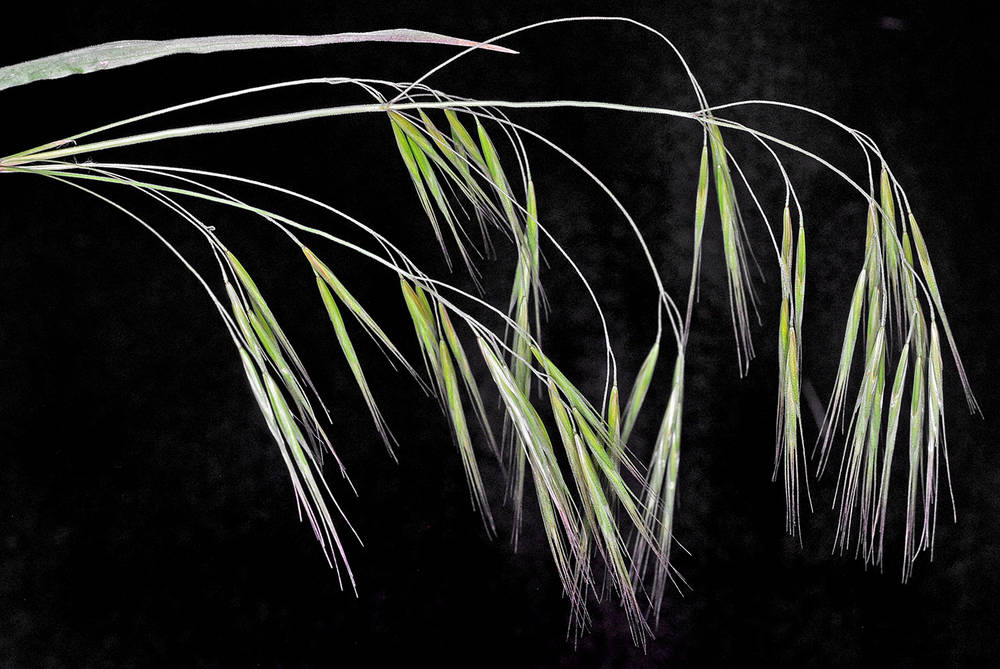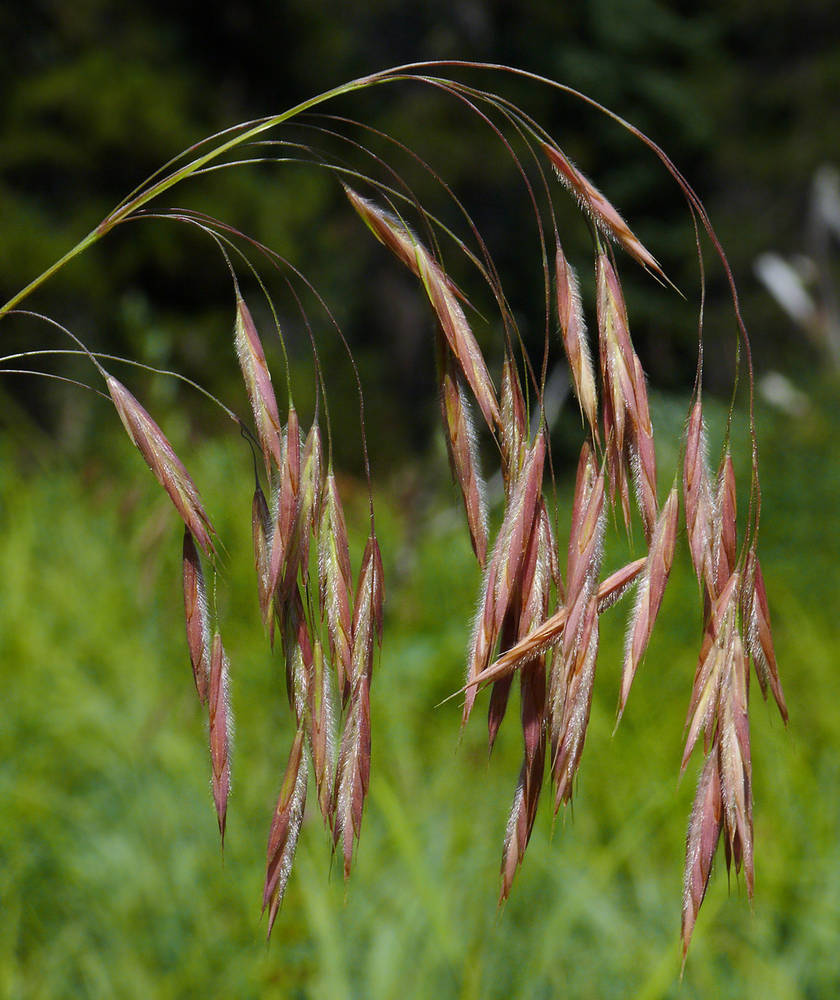Bromus tectorum
Bromus ciliatus
cheatgrass, downy brome, downy chess
fringed brome
puberulent.
internodes glabrous;
nodes (3)4–7(8), pubescent or the lower culms glabrous.
sheaths densely and softly retrorsely pubescent to pilose; upper sheaths sometimes glabrous;
blades 1–16 cm × 1–6 mm, softly hairy on both surfaces.
basal sheaths retrorsely pilose, sometimes glabrous; upper sheaths glabrous;
throats glabrous or pilose;
ligules 0.4–1.4 mm;
blades 13–25 cm × 4–10 mm; flat;
lower surface glabrous, sometimes pilose;
upper surface usually pilose, sometimes glabrous.
5–20 × 3–8 cm; open, nodding;
branches 1–4 cm, drooping, 1-sided and longer than the spikelets, usually at least 1 branch with 4–8 spikelets.
10–20 × approximately 12 cm; open, nodding;
branches ascending, spreading, or drooping.
10–20 mm, moderately laterally compressed, not densely crowded, 4–8 florets.
15– 25 mm, elliptic to lanceolate; terete to moderately laterally compressed, with 4–9 florets.
villous, pubescent, or glabrous;
lower glumes 4–9 mm, 1-veined;
upper glumes 7–13 mm, 3–5-veined.
glabrous;
lower glumes 5.5– 7.5 mm, 1(3)-veined;
upper glumes 7.1–8.5 mm, 3-veined.
9–12 mm, lanceolate, glabrous or pubescent to pilose, 5–7-veined;
tips acuminate; hyaline; bifid, with teeth 0.8–2(3)mm, awned;
lemma awns 10–18 mm; straight.
9.5–14 mm, elliptic to lanceolate, rounded over the back; backs glabrous or scabrous; lower 50–67% of margins conspicuously hirsute;
tips obtuse to acute; entire;
lemma awns 2–4(5)mm; straight.
0.5–1 mm.
1.5–2 mm.
=14.
=14.
Bromus tectorum
Bromus ciliatus
Disturbed areas, sagebrush steppe, degraded grasslands, roadsides. 0–2400 m. BR, BW, Casc, Col, CR, ECas, Lava, Owy, Sisk, WV. CA, ID, NV, WA; throughout North America; worldwide. Exotic.
Bromus tectorum is a relatively short grass with drooping inflorescences. Similar B. sterilis and B. diandrus have longer glumes, lemmas, and awns, and spikelets that hang down at a shallower angle than those of B. tectorum. The introduction of B. tectorum to shrub steppe habitats during a time of massive overgrazing in the late 1800s has made restoration of native plant communities difficult or impossible, even where grazing no longer occurs. Fast-growing B. tectorum seedlings outcompete slower growing native grass seedlings for water in drying soils. At maturity, the awns make B. tectorum unpalatable to livestock.
Moist montane meadows, thickets, woodlands, and stream banks. 1000–2000m. BR, BW, Casc, ECas. CA, ID, NV, WA; north to AK, east to Labrador and VA, south to Mexico. Native.
Bromus ciliatus has long-hairy lemma margins like B. laevipes, however, the latter species has 5-veined upper glumes and longer anthers.
Barbara Wilson, Richard Brainerd, Nick Otting
Barbara Wilson, Richard Brainerd, Nick Otting
- Local floras:
BC,
CA,
OR,
WA
- Local Web sites:
CalFlora,
CalPhotos,
Flora NW,
PNW Herbaria
WildflowerSearch
iNaturalist (observations)
USDA Plants Database
- LBJ Wildflower Center
- SEINet
- Plants of the World Online
- Encyclopedia of Life
- Wikipedia
- Google Image Search
- Local floras:
BC,
CA,
OR,
WA
- Local Web sites:
CalFlora,
CalPhotos,
Flora NW,
PNW Herbaria
WildflowerSearch
iNaturalist (observations)
USDA Plants Database
- LBJ Wildflower Center
- SEINet
- Plants of the World Online
- Encyclopedia of Life
- Wikipedia
- Google Image Search





